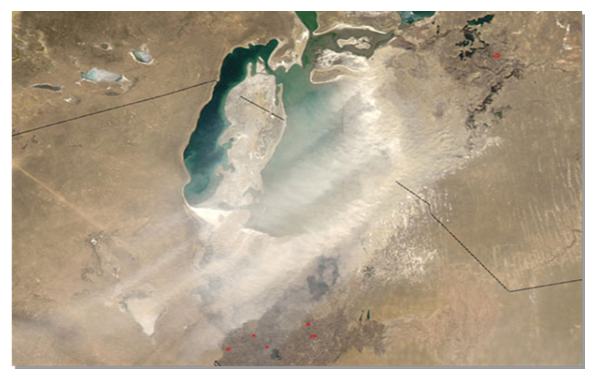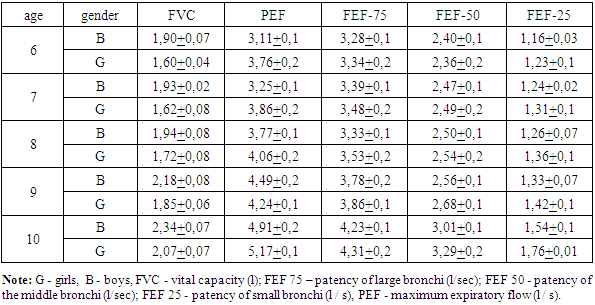-
Paper Information
- Paper Submission
-
Journal Information
- About This Journal
- Editorial Board
- Current Issue
- Archive
- Author Guidelines
- Contact Us
International Journal of Virology and Molecular Biology
p-ISSN: 2163-2219 e-ISSN: 2163-2227
2022; 11(2): 24-28
doi:10.5923/j.ijvmb.20221102.03
Received: May 20, 2022; Accepted: Jun. 12, 2022; Published: Jun. 15, 2022

The Ecological Situation and Its Impact on the Health Status of the Children’s Population of the Southern Aral Sea Region
N. P. Mirametova1, S. M. Mambetullaeva2, U. T. Azilova1, E. T. Allamuratov1, K. S. Abdullaev1
1Nukus State Pedagogical Institute, Uzbekistan
2Doctor of Biological Sciences, Karakalpak Scientific Research Institute of Natural Sciences, Uzbekistan
Copyright © 2022 The Author(s). Published by Scientific & Academic Publishing.
This work is licensed under the Creative Commons Attribution International License (CC BY).
http://creativecommons.org/licenses/by/4.0/

The article presents the results of a study of the features of the functional state of the cardiorespiratory system in children in the conditions of the South Aral Sea. The study of the patency of various sections of the tracheobronchial tree showed that in boys with age there is a tendency to increase bronchial patency. An increase in bronchial patency with the age of children with insignificant differences in the value of the vital capacity of the lungs can be attributed to the regional features of the external respiration system. It has been established that there is a relationship between physical development and functional characteristics of the circulatory system in children born and living in the South Aral Sea region. The data obtained suggest that the circulatory system in children is very sensitive to adverse environmental factors in the South Aral Sea region, thereby reducing their adaptive capacity and contributing to the formation of conditions for the development of diseases.
Keywords: South Prearalie, Cardiorespiratory system, Child population, Physical development, External respiration, Blood circulation, Environmental factors
Cite this paper: N. P. Mirametova, S. M. Mambetullaeva, U. T. Azilova, E. T. Allamuratov, K. S. Abdullaev, The Ecological Situation and Its Impact on the Health Status of the Children’s Population of the Southern Aral Sea Region, International Journal of Virology and Molecular Biology, Vol. 11 No. 2, 2022, pp. 24-28. doi: 10.5923/j.ijvmb.20221102.03.
1. Introduction
- The transformations of the ecosystem of the Aral Sea region, which occur as a result of a sharp change in the water regime, are numerous and varied. Under the conditions of the development of anthropogenic desertification processes, salts are removed from the dried bottom of the Aral Sea, degradation of the vegetation cover is observed, and the intensity of salt accumulation processes in the soil increases. On the dried bottom, new, shallow groundwater horizons are formed, with a high capillary rise of moisture and mineralization from 20 to 100 g/l. After the second year of drying the Aral Sea bottom, the coastal areas turn into plump salt marshes, the dryness and flowability of the soil increases. The resulting removal of salts to adjacent irrigated lands causes a significant decrease in crop yields [6]. The strategy of transforming the environment in order to satisfy a person's continuously growing needs, changing individual elements of the natural environment without taking into account the systemic organization of the relationship between nature and society, in general, led to changes in a number of certain parameters of the natural environment, which together reduce its quality and threaten the possibility of sustainable development [6]. Environmental pollution is a complex and multifaceted problem. In the conditions of the drying up of the Aral Sea, this problem is exacerbated by the removal of toxic salts (sulphates and chlorides) from the dried bottom (Fig. 1). The dust-salt transfer factor (70 million tons/year) has become dominant in the deterioration of atmospheric air quality. Modeling of salt transfer from the post-aquatic land of the Aral Sea showed a multiple excess of MPC during salt and dust storms [4].
 | Figure 1. Wind removal of salts on March 15, 2002, = synthesized (1st-3rd channels) NOAA satellite image |
2. Material and Methods
- The surveyed contingent was a group of children aged 6 to 10 years. Geographically, all the subjects were divided into 3 groups in accordance with the place of permanent residence. The functional state of the children's body was assessed based on the results of a study of the function of external respiration (VC) by spirometry; cardiovascular system (heart rate, blood pressure). The functions of external respiration were studied by the method of pneumotachometry on the apparatus “Polyanalyzer - PA5-02”. Assessment of the parameters of external respiration was carried out in a state of relative rest, in a sitting position. In the course of the study, the absolute values of external respiration indicators and their relationship to the average statistical norm, expressed as a percentage, were determined: FVC - vital capacity of the lungs (l); FEF 75 – patency of large bronchi (l/sec); FEF 50 - patency of the middle bronchi (l/sec); FEF 25 - patency of small bronchi (l/sec).The evaluation of the results of the study and their mathematical processing were carried out according to the methods recommended in biological studies [9] and using the Microsoft Excel analysis package. Statistical methods used in the processing of the obtained material included determining the reliability of the obtained materials according to Student's t-test (the lower limit of significance was taken to be a significance level of 95% (p <0.05)); conducting a correlation analysis of the indicators of the compared groups, with the determination of the correlation coefficient R by the Pearson method (significant correlation was considered when the coefficient was 0.7 or more) [9].The analysis of the heart rate of children allows to determine the activity of the autonomic nervous system (ANS) in the implementation of the regulation of the cardiovascular system and to assess the degree of tension of the regulatory systems. The trend towards the growth of pathological deviations of blood pressure in children puts the problem of studying the circulatory system in a number of urgent problems of modern human physiology. Statistical analysis of heart rate is a research method recognized in applied and special physiology. It is based on the developments of R.M. Baevsky and others [3,5], which were originally intended to predict the state of a person in space flight, complex operator activities, etc. Currently, this method is used to determine the type of regulation of cardiac activity.
3. Results and Discussion
- The respiratory system is a boundary system and is in direct contact with the external environment and one of the first to respond to changes in external conditions, pollution of the surface layer of air. The main purpose of respiration is the delivery of oxygen to the tissues and the removal of carbon dioxide formed as a result of oxidative processes. In accordance with the generally accepted concept of P.K. Anokhin’s respiratory system is a complex of formations, including central (regulatory) and peripheral (perceiving) nervous components and working devices, functionally combined into a single system, the end effect of which is to maintain the relative constancy of the gas composition of blood and body tissues.Studies of the function of external respiration provide essential information about the state of the adaptive mechanisms of the child's body. In response to a change in the quality of atmospheric air on the part of external respiration, first of all, bronchial patency changes. The level of bronchial patency is used to judge the state of adaptive changes. Such relative indicators as the vital capacity of the lungs, when assessing physical development, simultaneously characterize the functional capabilities of the organism [6,11,15]. In the course of the study, we found that the child's body has two important periods in the development of the external respiratory system: at 6-7 years old, there is a significant decrease in bronchial resistance, which leads to an increase in the volume of inhalation and exhalation, and 8-10 years - a period of intensive increase in volume lungs. The general patterns of development of the functions of external respiration, its reserve and adaptive capabilities in the ontogeny of children have been comprehensively studied by specialists [1,2,5,6]. So, we note that according to experts, at the age of 8-12 years, there is a smooth maturation of the morphological structures of the lungs. However, between 8-9 years of life, the lengthening of the bronchial tree prevails over its expansion. As a result, the decrease in dynamic airway resistance slows down, and there is no dynamics of tracheobronchial resistance [2]. The greatest growth and development of the respiratory system occurs during puberty [5]. By the beginning of puberty, the total volume of the lungs increases 10 times, and by its ring - 20 times compared with those of a newborn. The cartilage of the bronchi in children is soft, flexible and easily springy. Elastic fibers are relatively poorly developed. The mucous membrane of the bronchi is rich in blood vessels, but relatively dry. According to N.A. Skoblina (2008), the final branching of the bronchial tree (segmental, subsegmental and terminal bronchi, bronchioles, alveolar ducts) ends by 7 years [13].The results obtained on the functional indicators of the organism of children 6-10 years old indicate that in the process of development of children, the indicators of lung capacity (VC) tend to increase (Table 1). The vital capacity of the lungs in a child of 5-7 years old is 1200 ml in boys and 850 ml in girls. At 8-10 years old, this figure is 2000 ml and 1700 ml, respectively. [16]. So, in boys at the age of 6 and 7, the vital capacity (FVC) indicators were 1.90±0.07 l and 1.93±0.02 l, respectively. The greatest increase in FVC was observed in children aged 9 and 10; in boys, the FVC index was 2.18±0.08 and 2.34±0.07 l (p<0.001), respectively.
|
4. Conclusions
- The general trend demonstrates the relative stabilization of age-related changes in R-R in both boys and girls. At the same time, the gradient of change in R-R intervals in girls was lower than this indicator than in boys (R-R gradient for girls - 0.05 sec, boys - 0.09 sec), by almost 50%, and the gradients of changes in cardiorhythmogram parameters prevailed in boys. However, taking into account the high pollution of the surface layer of the atmosphere in the South Aral Sea region, an increase in bronchial patency detected in children was regarded by us as an undesirable reaction and one of the factors contributing to the development of bronchopulmonary pathology. An increase in the patency of the bronchi in the conditions of dustiness of the surface layer of air is physiologically irrational. The persistence of this reaction in the future can lead to various pathological changes in the bronchopulmonary apparatus, which partly explains the growth of bronchopulmonary pathology in the children's population in the South Aral Sea region. The data obtained are consistent with the results of a study by specialists and suggest that the circulatory system in children is very sensitive to adverse environmental factors in the South Aral Sea region, thereby reducing their adaptive capabilities and contributing to the formation of conditions for the development of diseases.
 Abstract
Abstract Reference
Reference Full-Text PDF
Full-Text PDF Full-text HTML
Full-text HTML